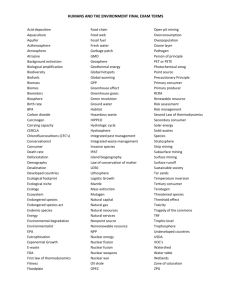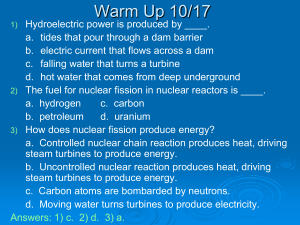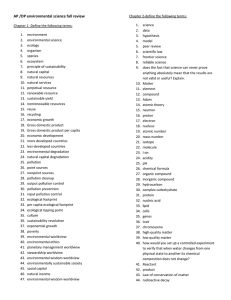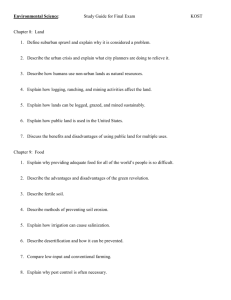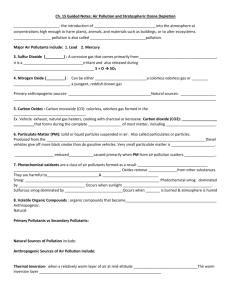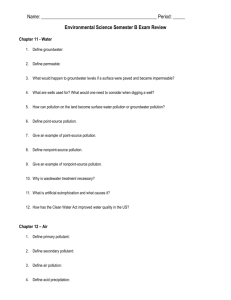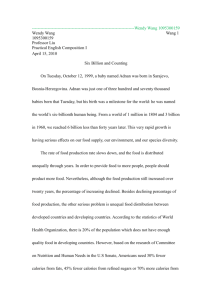Word
advertisement
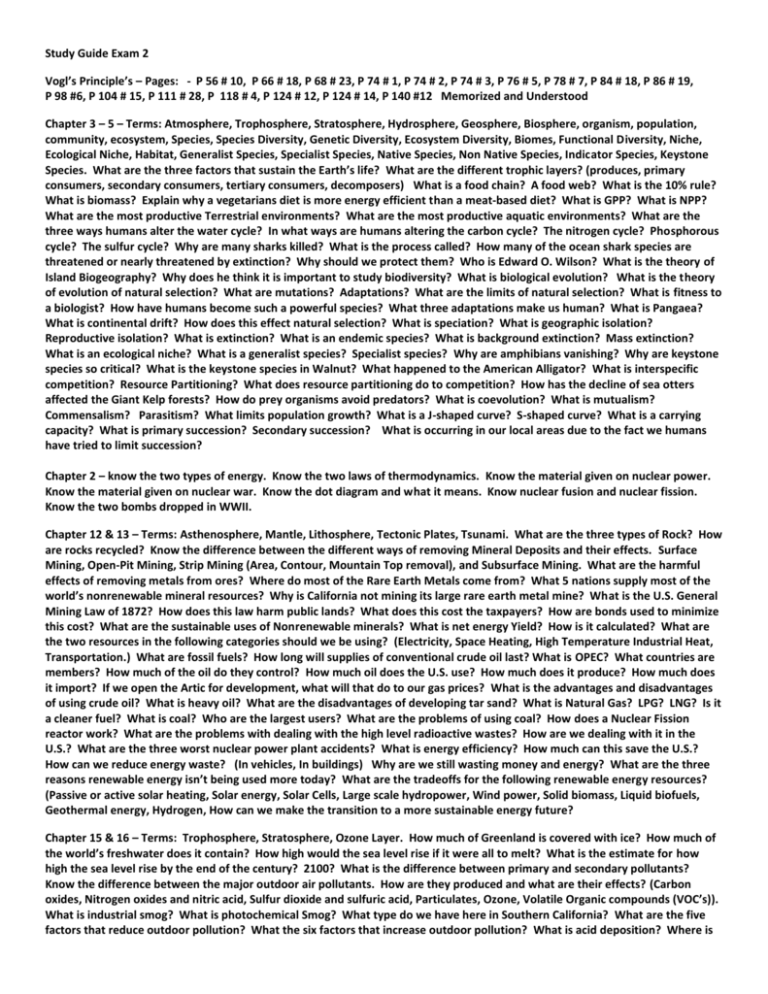
Study Guide Exam 2 Vogl’s Principle’s – Pages: - P 56 # 10, P 66 # 18, P 68 # 23, P 74 # 1, P 74 # 2, P 74 # 3, P 76 # 5, P 78 # 7, P 84 # 18, P 86 # 19, P 98 #6, P 104 # 15, P 111 # 28, P 118 # 4, P 124 # 12, P 124 # 14, P 140 #12 Memorized and Understood Chapter 3 – 5 – Terms: Atmosphere, Trophosphere, Stratosphere, Hydrosphere, Geosphere, Biosphere, organism, population, community, ecosystem, Species, Species Diversity, Genetic Diversity, Ecosystem Diversity, Biomes, Functional Diversity, Niche, Ecological Niche, Habitat, Generalist Species, Specialist Species, Native Species, Non Native Species, Indicator Species, Keystone Species. What are the three factors that sustain the Earth’s life? What are the different trophic layers? (produces, primary consumers, secondary consumers, tertiary consumers, decomposers) What is a food chain? A food web? What is the 10% rule? What is biomass? Explain why a vegetarians diet is more energy efficient than a meat-based diet? What is GPP? What is NPP? What are the most productive Terrestrial environments? What are the most productive aquatic environments? What are the three ways humans alter the water cycle? In what ways are humans altering the carbon cycle? The nitrogen cycle? Phosphorous cycle? The sulfur cycle? Why are many sharks killed? What is the process called? How many of the ocean shark species are threatened or nearly threatened by extinction? Why should we protect them? Who is Edward O. Wilson? What is the theory of Island Biogeography? Why does he think it is important to study biodiversity? What is biological evolution? What is the theory of evolution of natural selection? What are mutations? Adaptations? What are the limits of natural selection? What is fitness to a biologist? How have humans become such a powerful species? What three adaptations make us human? What is Pangaea? What is continental drift? How does this effect natural selection? What is speciation? What is geographic isolation? Reproductive isolation? What is extinction? What is an endemic species? What is background extinction? Mass extinction? What is an ecological niche? What is a generalist species? Specialist species? Why are amphibians vanishing? Why are keystone species so critical? What is the keystone species in Walnut? What happened to the American Alligator? What is interspecific competition? Resource Partitioning? What does resource partitioning do to competition? How has the decline of sea otters affected the Giant Kelp forests? How do prey organisms avoid predators? What is coevolution? What is mutualism? Commensalism? Parasitism? What limits population growth? What is a J-shaped curve? S-shaped curve? What is a carrying capacity? What is primary succession? Secondary succession? What is occurring in our local areas due to the fact we humans have tried to limit succession? Chapter 2 – know the two types of energy. Know the two laws of thermodynamics. Know the material given on nuclear power. Know the material given on nuclear war. Know the dot diagram and what it means. Know nuclear fusion and nuclear fission. Know the two bombs dropped in WWII. Chapter 12 & 13 – Terms: Asthenosphere, Mantle, Lithosphere, Tectonic Plates, Tsunami. What are the three types of Rock? How are rocks recycled? Know the difference between the different ways of removing Mineral Deposits and their effects. Surface Mining, Open-Pit Mining, Strip Mining (Area, Contour, Mountain Top removal), and Subsurface Mining. What are the harmful effects of removing metals from ores? Where do most of the Rare Earth Metals come from? What 5 nations supply most of the world’s nonrenewable mineral resources? Why is California not mining its large rare earth metal mine? What is the U.S. General Mining Law of 1872? How does this law harm public lands? What does this cost the taxpayers? How are bonds used to minimize this cost? What are the sustainable uses of Nonrenewable minerals? What is net energy Yield? How is it calculated? What are the two resources in the following categories should we be using? (Electricity, Space Heating, High Temperature Industrial Heat, Transportation.) What are fossil fuels? How long will supplies of conventional crude oil last? What is OPEC? What countries are members? How much of the oil do they control? How much oil does the U.S. use? How much does it produce? How much does it import? If we open the Artic for development, what will that do to our gas prices? What is the advantages and disadvantages of using crude oil? What is heavy oil? What are the disadvantages of developing tar sand? What is Natural Gas? LPG? LNG? Is it a cleaner fuel? What is coal? Who are the largest users? What are the problems of using coal? How does a Nuclear Fission reactor work? What are the problems with dealing with the high level radioactive wastes? How are we dealing with it in the U.S.? What are the three worst nuclear power plant accidents? What is energy efficiency? How much can this save the U.S.? How can we reduce energy waste? (In vehicles, In buildings) Why are we still wasting money and energy? What are the three reasons renewable energy isn’t being used more today? What are the tradeoffs for the following renewable energy resources? (Passive or active solar heating, Solar energy, Solar Cells, Large scale hydropower, Wind power, Solid biomass, Liquid biofuels, Geothermal energy, Hydrogen, How can we make the transition to a more sustainable energy future? Chapter 15 & 16 – Terms: Trophosphere, Stratosphere, Ozone Layer. How much of Greenland is covered with ice? How much of the world’s freshwater does it contain? How high would the sea level rise if it were all to melt? What is the estimate for how high the sea level rise by the end of the century? 2100? What is the difference between primary and secondary pollutants? Know the difference between the major outdoor air pollutants. How are they produced and what are their effects? (Carbon oxides, Nitrogen oxides and nitric acid, Sulfur dioxide and sulfuric acid, Particulates, Ozone, Volatile Organic compounds (VOC’s)). What is industrial smog? What is photochemical Smog? What type do we have here in Southern California? What are the five factors that reduce outdoor pollution? What the six factors that increase outdoor pollution? What is acid deposition? Where is this worse in the U.S? What are the harmful effects? How can it be reduced? According to the World Health Organization (WHO), what is the most serious air pollution problem? Especially for who? What are the four most dangerous indoor air pollutants in developed countries? How can we reduce outdoor air pollution? How do we reduce indoor air pollution? What are greenhouse gases? What was the level of CO2 in 1850? 2010? What is the estimates for 2050? 2100? What level is considered the tipping point? What are the consequences for global warming? What are the two basic approaches to dealing with the projected harmful effects of global climate disruption? What is threatening the ozone layer? What damage does it do? How can we reverse it? What is E-waste? Where is the U.S waste going? What is the cradle to grave approach? What is solid waste? What are the two types? What is hazardous or toxic waste? How much solid waste does the the U.S. produce? How much “MSW” does the U.S. generate each year? What is integrated waste management? What are the three R’s? What are the two types of recycling? How much of the MSW does the U.S. recycle? What are the advantages and disadvantages of recycling? What are bioplastics? What are the advantages and disadvantages of burning solid waste? What are the advantages and disadvantages of burying solid waste? How can we detoxify hazardous wastes? What is RCRA? What is CERCLA? How can we make the transition to low-waste societies? Know the notes from the movies and websites shown Extinction Inconvenient Truth The Story of Stuff


